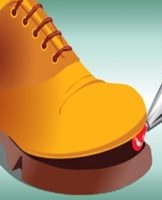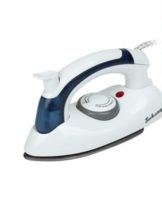DIY step-by-step instructions for disassembling and repairing a coffee grinder
The household electric grinder is convenient and easy to use. The compact device has enough power to powder any solid composition in minutes. Kitchen appliances fail due to non-compliance with the rules of operation, long service life. There are no special difficulties in repairing a coffee grinder, except for the breakdown of the electric motor.
General design of the device
The name of the coffee grinder speaks for its purpose. But the electric device has found a wider application: it grinds medicinal herbs, roots, dried fruits. In general terms, it is an electrically driven grinder. A kind of grinding wheels and rotary cutters are used as a grinder.
grinding wheel
The grinder has 3 sections:
- bunker for raw materials;
- Work zone;
- container for the finished product.
Two metal cones of different diameters are ground coffee beans. The grind regulator increases or decreases the gap between the friction surfaces, which changes the size of the finished fraction.
Shock
In a rotary coffee grinder, the grind is carried out by the knife(s) rotating at high speed. The whole process takes place in one area: loading, threshing, removal of the grinds.
How to properly disassemble with your own hands
The sequence of dismantling the coffee grinder depends on the method of fastening its structural elements: latches, bolts, screws.
Soviet and Mikma IP 30
Devices released before the 90s of the last century had a high build quality and retain their functionality to this day.
To eliminate the malfunction, the coffee grinders are disassembled in the following order:
- Remove the knife: unscrew the slot at the bottom of the glass with a screwdriver in a clockwise direction.
- Remove the glass by first unscrewing the plastic nut 90 degrees.
- The washer is removed from the drive shaft.
- The latch is removed from the upper cup holder by simultaneously pressing the latch and latch and turning them clockwise.
- Pressing the spring, remove the switch.
- Remove the shaft protection washer.
- Remove the motor after disconnecting the wire, while bending the ring and unscrewing the screws.
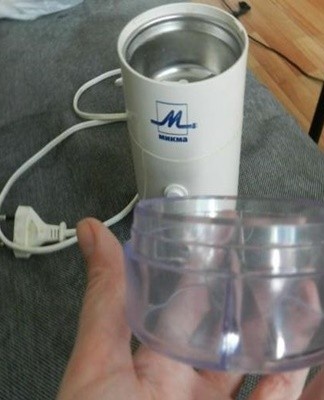
The MIKMA IP 30 coffee grinder has a different dismantling option:
- The divider is removed by unscrewing the screw at the bottom of the device.
- Remove the bracket from the metal cup holder by twisting it with pliers.
- Remove the cup holder with protective case.
- Detach the metal bar from the grinder body by moving it counterclockwise.
- Move the contact under the button and remove the motor.
- Remove oil seal, dampers on shaft.
- Remove the spring, remove the button.
- Unscrew the screws and release the electric cable.
This completes the disassembly process and you can start repairing the coffee grinder.
Bosch
Bosch rotary coffee grinders begin to disassemble from the bottom of the glass: they squeeze the slightly plastic case, pick up the gap with a screwdriver. The latches come off, the cover is removed. To remove the knife, hold the bolt from below with a screwdriver on the shaft on which the knife is mounted, while unscrewing the splitter. Unscrew in the direction of rotation of the shaft.
To detach the plastic top from the metal cup holder where the grinding takes place, the latch is hooked with a screwdriver.
The MKM-6000 model is opened by two people: one holds the coffee grinder in a horizontal position, the other inserts a screwdriver where the latch is (1.5 centimeters from the entrance of the cable). The thin tip of the screwdriver is pressed in at an acute angle, with the second screwdriver they help to expand the hole and remove the latches.
Other brands
Other coffee grinder disassembly options differ in how the knife and bottom are removed. The divider with a plastic cap above the bolt is removed without affecting the axis: the cap is removed, the knife unscrews clockwise. The bottom is fixed not with latches, but with screws, which allows them to get inside the case.

How standard models are repaired
Coffee grinders with the same type of function have the same failure reasons:
- broken knife;
- contamination of structural parts by coffee dust;
- rust on rotating parts;
- twisting of the conductor wires.
Getting coffee grinders back to work is much the same.
Power cable
Cord twisting and breakdown of electrical conduction are common failures in long life coffee grinders. Determining the fault is simple: wiggle the wire connected to the network.If in a certain position of the cable the coffee grinder "wakes up", then it needs to be changed. If it is impossible to determine the exact location of the breakdown, the entire cable is changed. The section and length of the new wire must match the failed one. Cords with and without a plug are commercially available. If the wire and plug were not purchased in the kit, install the power cord first.
To make a replacement, disassembly is required to the point of contact with the button and motor.
The wire may break inside the housing at the point of contact with the switch. To check, you need to move the button. Starting a coffee grinder means taking the structure apart, finding the breakage and fixing it with a soldering iron.
The device does not start
The plugged-in grinder does not respond to the start button. The reason may be the failure of the start button. It is not difficult to fix it, because most often the reason lies in the coffee dust that has settled on the contacts. Engine failure is essential for continued use of the chipper. The cost of repairs will not be much cheaper than buying a new car.
Knife turns unevenly
Interrupted rotation of the separator indicates a malfunction of the engine. For a final diagnosis, it is necessary to contact the service center.
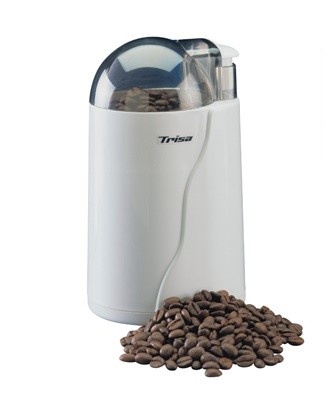
Burning smell or tense engine noise
A symptom of motor failure, contaminated bushings or bearings is when the machine “roars” and the cutters/cones move slowly or stay put. A burning smell appears. It will be possible to repair the coffee grinder with such symptoms if the motor windings are not damaged.
An audit of the shaft and the sliding elements is carried out: bush or bearing. In the presence of dust, pollution, corrosion, the parts are carefully cleaned and lubricated. Assembly and testing are in progress. If the result is negative, the grinder will need to be replaced.
Another cause of malfunction is the drying out of bearing grease. Determine the defect when completely disassembling the coffee grinder, including the motor.
Other cases
Other types of home repairable coffee grinder failures:
- split or crack in the knife;
- crack in the plastic cover;
- in the plastic part of the case.
In the first case, they are replaced by a similar one for this model. The cork can be made by choosing a bottle of the required diameter. Laying is carried out with a hair dryer. Minor damage is sealed with epoxy glue, cold welding or hot melt glue.
How to set up manual grinding
Different types of coffee makers are used to prepare coffee:
- geyser;
- drop;
- empty;
- French;
- Turks.
Brewing options depend on grind fraction. Manufacturers install timers on electric rotary coffee grinders for these purposes. The operating modes determine the duration of the grinding: the longer the fraction, the finer the fraction. The disadvantage of such coffee grinders is the impossibility of obtaining a homogeneous composition.
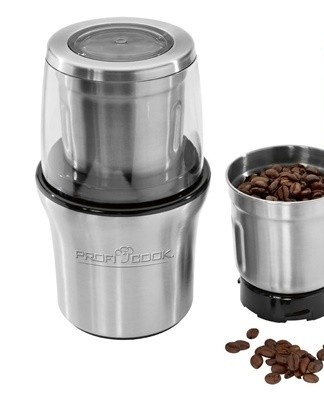
For better grinding, grinding wheels are used. The adjustment is made using a disc under the hopper. It has letters and notches. By turning the disc to the right, the distance between the grinding wheels is reduced, that is, the finished fraction will be smaller. Conversely, turning to the left separates the wheels, making the grinding coarser.The adjustment consists of linking the regulator to the extraction time of the drink and its quality. The first mandatory step is to determine the loading dose in the bunker, which cannot be changed without changing the setting. The quality of the grind is determined by the taste and appearance of the coffee.
This does not affect the amount of water and the preparation time of the coffee drink. If the coffee is bitter, it means that you need to refine the grind (turn the disc to the right), if it is sour - make it larger (turn to the left). The coffee tablet should be moderately moist and easily shaken off the holder. The standard brewing time for espresso is 23-28 seconds.
Possible problems
The main problem when repairing a coffee grinder is that the model is not repairable or lacks experience in dismantling.If an electric motor breaks down, you should not restore it yourself without knowledge, experience and tools.
Rules of maintenance and operation
Coffee grinders cannot be washed under running water. The containers should be wiped with a damp cloth after each grinding. The instructions for the electrical appliance indicate which products are not recommended to grind there. Rotary mills are more widely used than grinding wheels.
Failure to observe which operating rules will disable the coffee grinder in advance:
- single activation for more than 30 seconds;
- repeated ignition with a short time interval;
- the loading of raw materials in the bunker is above standard.
When not in use, the grinder should be disconnected from the power supply.

